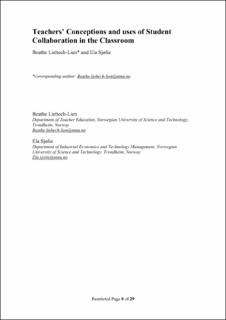Teachers’ conceptions and uses of student collaboration in the classroom
Peer reviewed, Journal article
Accepted version
Permanent lenke
https://hdl.handle.net/11250/2724683Utgivelsesdato
2020Metadata
Vis full innførselSamlinger
Originalversjon
10.1080/00131881.2020.1839354Sammendrag
Background
The ability to collaborate is a central competence that students need to be taught in school, in order to prepare them for the social and work realities that they will face in the 21st century. Research shows that students often study in educational settings that do not promote collaboration with peers. Based on a renewed focus on the ability to collaborate as an educational outcome in itself, this paper explores how teachers think about and use student collaboration in the classroom.
Purpose
This study, conducted in Norway, aimed to better understand teachers’ pedagogical reasons for using collaboration. Such insight can offer valuable knowledge about how collaboration is understood and might influence classroom practice.
Methods
A small scale, detailed qualitative study was undertaken. The participants comprised a teacher team of four lower secondary school teachers, and data were collected through individual, semi-structured interviews. Data were analysed in depth, using content analysis methods.
Findings
Five main themes were identified that illuminated the teachers’ conceptions of collaboration: (1) collaborative activities as a valued ingredient in teaching, (2) collaboration as organising, (3) collaboration as a tool, (4) collaboration as demanding and (5) collaboration skills ‘taken for granted’. The findings indicated that collaboration was regarded as a valued ingredient in teaching practice, despite sometimes being challenging to use. Further, it appeared that that the dual potential that lies in using collaborative activities – i.e. as a way to work with, and develop, the ability to collaborate – can be overshadowed by an academic focus. Interestingly, learning how to collaborate was rarely regarded as being an educational outcome in itself.
Conclusion
This paper highlights the need to accentuate the social pedagogy of collaborative activities, in order to prepare students for the social and work realities that lie before them. Opportunities for teachers to develop their understanding of student collaboration and learn about how best to structure teaching and learning to capture the dual potential that lies within should be embedded in teacher education and on-going professional learning.
